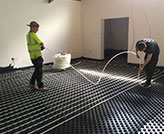If you are constructing a building in Manchester, or for that matter anywhere else, it may well be that you are including underfloor heating. This has so many advantages over and above a radiator system that it is hard to know where to begin. Suffice it to say that, compared to underfloor heating, radiators are out of date – so “last century”.
Apart from any other considerations, radiators take up space in a room, whereas when underfloor heating is installed in a new building it has no effect on the room space. Furthermore, with the best will in the world, you can hardly call radiators attractive.
Underfloor heating covers the whole room, so the result is that it heats evenly. When you have radiators, this doesn’t happen. You will get areas near the radiator that are warmer than others – so you also have what are really “cold spots”.
There are two types of underfloor heating – electric and water based. An electric system uses electric heating cables under the floor whereas a water-based system use water that is preheated and runs under the floor using a pipe system. Of course, we all know that electricity is expensive, and is only likely to get more so, and this is why many people are opting for a water-based system.

Big Advantages
At UK Screeds, we install underfloor heating systems using the water pipe method which uses less energy to heat the room. We then cover the heating pipes using a liquid floor compound in Manchester, which has some big advantages over a sand and cement mix. Possibly the most important aspect of a liquid floor compound in Manchester is that it will totally envelop the pipe system without leaving any air pockets.
If you use a sand and cement mix it has to be laid by hand by a worker on hands and knees using a trowel to level it out. It is almost impossible to do this without leaving air gaps in some places, and that means that the heat transfer into the room above will not be even.
However, that is not the end of it. A liquid screed such as we install has almost twice the thermal transfer properties of sand and cement. What that means is that less energy is used to heat the room, thus saving money on the bills. That saving goes on forever. It also means that the room will heat up faster.







